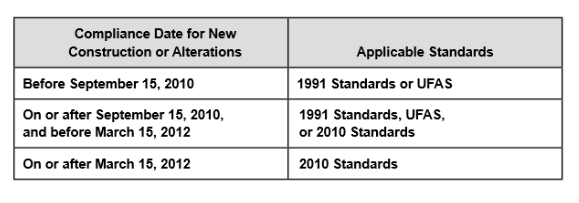Main Issues
As building requirements constantly evolve and are implemented, BOMA International’s codes team aims to provide its members with the most up to date building codes so that buildings can be as safe and accessible as possible. Because the Americans with Disabilities Act, OSHA, and ASHRAE are so critical in providing accessibility for those who are disabled, guaranteeing safety in commercial buildings, and maintaining the most energy efficient buildings, respectively, BOMA International is committed to informing its members of the most recent regulations to the ICC, ADA, OSHA and ASHRAE Standards so that proper building changes can be implemented as quickly as possible.
Americans with Disabilities Act
BOMA International strongly supports the “next generation” of accessibility requirements in new buildings and alterations while “grandfathering” conditions that meet current Department of Justice standards (2010 ADA Standards).
BOMA continues to work to ensure that new regulations, codes, and standards provide:
- Increased consistency in accessibility requirements
- More reasonable and clearer technical requirements
- More consistent interpretation, application, and enforcement
ADA Background
Signed into law in 1990, the Americans with Disabilities Act dramatically increased the protection and improvement of the rights of Americans with disabilities. As a result of this, accessibility has tremendously improved in buildings throughout the country. However, some attorneys are exploiting the ADA and attempting to make a profit rather than focusing on improving accessibility in commercial real estate buildings. While BOMA International fully supports the ADA, it aims to provide resources and information so that building owners and managers can improve accessibility in commercial real estate buildings as quickly and efficiently as possible.
Over the years, the U.S. Department of Justice has frequently revised the Americans with Disabilities Act Guidelines and published updated regulations. The most recent, revised regulations were published on December 2, 2016 and took effect on January 17, 2017. For more information regarding ADA regulations and updates, visit the Americans with Disabilities Act homepage.
-
The Guide to ADA Standards explains the regulations that apply to Title II (state and federal buildings) and Title III (places of public accommodation, businesses, and commercial facilities).
- The Guide to the ABA Standards describes the standards that apply under the ABA to all facilities receiving federal funding for any construction, alteration, or leased space.

OSHA (Occupational Safety and Health Act of 1970)
BOMA International encourages all building owners and managers to become familiar with the most recent changes to OSHA. The new regulations are intended to increase worker safety and limit the number of accidents associated with the use of stairs, ladders, and other elevated work surfaces.
To comply with OSHA standards, BOMA International encourages its members to:
-
Read the Fact Sheet on new OSHA rules
- Conduct background checks on all contractors who may offer to provide these services and verify that they meet the qualifications for inspecting
- Engage in OSHA’s free, non-punitive consultative inspections
- To contact a state agency, utilize the OSHA on-site consultation map
ASHRAE (American Society of Heating, Refrigerating and Air-Conditioning Engineers) Standards
The 2016 edition of ANSI/ASHRAE/IES Standard 90.1, Energy Efficiency for Buildings Except Low-Rise Residential Buildings, incorporates more than 120 updates to the 2013 version. During its development, BOMA International’s codes team worked to ensure the interests and concerns of the commercial real estate industry were heard, so that the updates would maximize energy efficiency without excessively increasing cost. The new edition is estimated to provide an 8.3 percent increase in energy savings over the 2013 edition.
The important updates include:
- A slight increase to the insulation requirements for metal buildings, doors and windows
- More stringent efficiency requirements for energy recovery systems
- A reduction in exterior and interior lighting allowances to reflect the increased usage of LEDs, and new control requirements for emergency lighting and parking lot occupancy sensors
- Appendix G, previously used only to rate LEED buildings, now able to be used as a stand-alone compliance path, offering more options to designers
- The standard will also be an alternate compliance path for the 2018 edition of ICC’S International Energy Conservation Code
To help commercial building owners and managers better understand the updates that were made, BOMA International has compiled a list of critical changes and their cost implications.